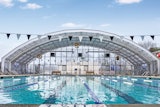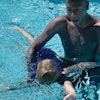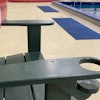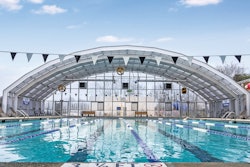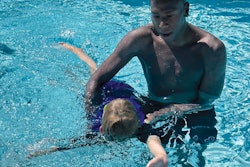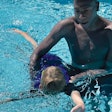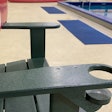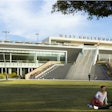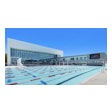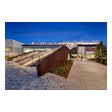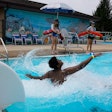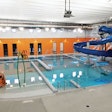Collegiate aquatic centers are increasingly incorporating design elements and equipment that accommodate high-activity usage.
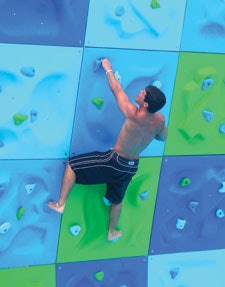 Photo of a student climbing the bouldering wall at the Southeast Missouri State University Aquatic Center
Photo of a student climbing the bouldering wall at the Southeast Missouri State University Aquatic CenterCertain that exercise enhances their thinking, reduces stress and improves their energy level, many college students consider it their most effective study break. (It's also a prime social outlet.) But lap swimming aside, most college pools don't offer much to students looking to work out rather than wade.
The trend in college pool design has for some years been toward campus aquatic facilities that can either host swimming competitions or accommodate recreational swimming opportunities, but have little in between to draw what you might call the active-recreation swimmer. For students who like to challenge themselves in the pool, typical leisure pool features - the zero-depth entry, vortex, bubble benches, waterslides and whirlpool spa - really do nothing for them in terms of strength, coordination and fitness. These are largely passive aquatic components that have brought college aquatic centers more in line with municipal aquatic centers. But that, it appears, is changing.
When designing a campus leisure aquatic facility, both passive users and active swimmers ought to be able to partake in recreational activities. The challenge is that in the college recreation market, these two types of swimmers are very different. Passive users look for soothing experiences without exerting significant amounts of physical energy; thus their needs are being met with the status-quo leisure pool. Passive swimming encompasses casual fitness experiences; the passive swimmer is primarily a pleasure seeker.
The active swimmer, by contrast, is a thrill seeker. Active swimmers crave excitement, the unusual - and bragging rights are a significant part of the experience, particularly for those who prior to their college experience were sports team participants.
A generation ago, the diving board - which requires of serious users a number of progressively more difficult skills and offers a social hub for "top this!" recreation - was ground zero for aquatics thrill-seekers. As forward-thinking schools are beginning to demonstrate, aquatic centers can be socially fun as well as soothing sanctuaries, and a small number of aquatics administrators are starting to incorporate innovative components that require skill and inspire competition.
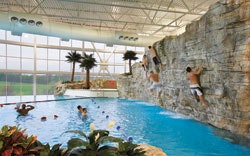 CLIFF NOTES The active pool at the Southeast Missouri State University Aquatic Center features water volleyball, a bouldering wall and a zip line that offers the thrill of whizzing through the air to a splash landing.
CLIFF NOTES The active pool at the Southeast Missouri State University Aquatic Center features water volleyball, a bouldering wall and a zip line that offers the thrill of whizzing through the air to a splash landing.For example, artificial surfing environments provide a challenging activity for which active swimmers have shown tremendous enthusiasm. A huge hit in the resort, cruise ship and water-park industry, surfing units may have begun to find a toehold in the college market. Pensacola Christian College, which is the first (and still only) college in North America that offers one, notes on its web site that, for the school's students, the attraction is "as much fun to watch as it is to ride."
Another component making its way into the college aquatic recreation scene is an aquatic climbing structure, a relatively affordable way to upgrade an existing pool with a new and physically challenging activity. Made of fiberglass finished with a gently textured, non-slip surface that can easily be deck-mounted, these units take up little space and have the advantage of being removable if necessary. Since many aging college facilities have removed their diving boards, adding a climbing structure can bring new life to an old pool.
The new Southeast Missouri State University Aquatic Center has incorporated several examples of the latest in active aquatic design, including a more expansive take on aquatic climbing. To supplement the hugely successful outdoor recreation programs at the university, the active pool showcases a dramatic, 40-foot-wide-by-14-foot-high bouldering wall. The wall leans out over the water, allowing climbers to traverse it through numerous waterfalls without the need for ropes or harnesses. The infinity-edge pool also features a rope swing and a zip line that offers the thrill of whizzing through the air to a splash landing. While supervision of these activities requires extra care (in particular, ensuring that swimmers keep their distance from the splash zones), the water underneath them provides the ultimate cushion.
The SEMO pool also features a water volleyball court that satisfies facility users who prefer a team activity. The floating net and boundary lines make for a more competitive game environment; water volleyball courts are offered by a number of suppliers of inflatable recreational products.
Water basketball, an old favorite for a one-on-one game of horse or a more competitive team game, can also be given more oomph by adding free-throw or three-point lines. With the water court taking on the dimensions of a real court, the intensity can be pushed to a higher level.
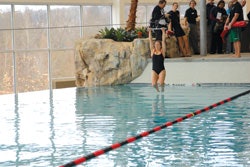 ZIP DRIVE Active swimmers crave excitement, the unusual - and bragging rights are a significant part of the experience.
ZIP DRIVE Active swimmers crave excitement, the unusual - and bragging rights are a significant part of the experience.Other aquatic recreational sports, such as underwater hockey, a relatively new no-contact sport played on pool bottoms, are gaining in popularity. According to USOA Underwater Hockey, "The pool should be 25 meters by 15 meters and two meters deep all the way across, but anything will do, even slopes (just change ends at half-time). Lead weights and three meters of rope can be used as goals, though the sound of the puck thunking into the back of a metal goal is very satisfying and should be experienced."
Another aquatic sport gaining in status is water polo - not just the Olympic variety, but also variations that feature inner tubes and even kayaks. Inner-tube water polo has been a popular intramural sport for years and does not require exceptional swimming ability. Because the water minimizes size and strength differences between the sexes, staging separate men's and women's events isn't necessary. About kayak polo, the web site of the Carolina Kayak Polo Club notes, "It is difficult to describe the passion and excitement that is created when a kayak water polo game is in progress. The participants - speeding the length of the pool, weaving through the opponent's lines of defense and spinning in their kayaks to receive a pass - create a fast and thrilling event."
Certain leisure pool staples can be utilized for active recreation. The University of Tennessee at Chattanooga's Aquatic and Recreation Center (construction of the aquatics phase began this month) will take the idea of a lazy river and kick it up a notch to create an indoor kayak course. With boulders that can be relocated for varying flow characteristics, the course will be anything but lazy. Being located in the heart of the eastern United States' best area for whitewater, the new facility will offer a comfortable wintertime training ground for kayakers. The current will be adjustable so that the less-daring student can enjoy the river in slower motion.
Another outdoor leisure pool standard, the rolling log, comes in floating versions for adult pool users who might relish a one-on-one challenge. Comprised of a buoyant log with stability rafts at either end, this amenity puts users' balance, skills and coordination to the test as they vie to be the last person standing.
Inflatables have become much more sophisticated in recent years. One targeting the youth market that could have college recreation potential is an off-the-shelf aquatic obstacle course (an example can be viewed at www.wibitsports.com) that offers individuals a challenge and aids in team building. This line of modular components - including a base, balance beam, bridge, slide, large oval platform, long jump and high jump - can in 20 to 30 minutes be configured into a variety of challenge courses or individual events, such as head-to-head races, time trials and team relays. Competitions and contests can engage fraternities and sororities, intramurals participants and summer campers - and even allow for national and international intercollegiate competition. Since the obstacle courses are standardized, event results can be entered into a web database where students can see how they rank with other competitors around the globe. This type of cutting-edge, measured, outcome-based competition is what makes participants want to come back for more so they can improve their scores.
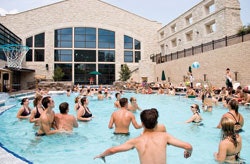 OUTSIDE SHOTS Activities at Truman's Pond at the University of Missouri-Columbia Student Rec Complex include water basketball and, of course, socializing.
OUTSIDE SHOTS Activities at Truman's Pond at the University of Missouri-Columbia Student Rec Complex include water basketball and, of course, socializing.Numerous fitness activities serving the active aquatic enthusiast can be integrated into the college physical education program. Ever-popular water walking can be accommodated through the inclusion of a current channel for resistive movement. A current channel, built as part of a leisure pool, provides water that travels at approximately three miles per hour, creating a passive adventure for inner-tube users or an opportunity for against-the-current walking or jogging as a non-programmed or programmed fitness activity. Deep-water aerobics likewise offers a muscular endurance workout. Simulated running in the deep end of a pool is aided by a flotation device (vest or belt), where the participant is tethered in one location. Aquatic fitness professionals estimate that 30 minutes of walking or jogging in shallow or deep water is equal to 80 minutes on land.
Finning, another aquatic fitness program, requires training fins or flippers, and takes place within a pool's lap lanes. A Navy SEALs aquatics class consists of finning, water jogging, deep-water aerobics and scuba instruction. Amphibious boot-camp programs incorporate land and water fitness in a fast-paced, military-style interval-training course with running in the pool, calisthenics, jumping jacks, pushups and football-style drills. Aqua-training workouts, usually performed with the supervision of a personal trainer for the purpose of improved athletic performance, can be as intense as desired.
Perhaps it is only a matter of time before the overflow crowds seen at most new college fitness centers discover the benefits of aquatic-based fitness. When they do, a number of pieces of fitness equipment, currently utilized mainly by athletes rehabilitating injuries, are available to offer students a high-resistance workout in a fun, refreshing and dynamic environment. The underwater treadmill, for example, replicates land-based movements - walking, jogging, sprinting - using the low-impact buoyancy of water. Same for the aquatic bike: Based on the classic land-based recumbent or stationary cycle, aquatic bikes offer cycling that can be enjoyed in a low-impact aquatic environment. The aerobic stepper has similarly been morphed into an aquatic aerobic stepper, providing all the benefits of the land-based activity (cardiovascular fitness, flexibility, muscle strength), but without the impact that can stress knees, calves, Achilles' tendons, hips and the spine.
With a little ingenuity, new and existing campus facilities can accommodate a wide range of users through aquatic fitness and active-recreation programs. The basic goal in the college setting should be to promote social interaction, friendly competition or personal accomplishment for participants of all skill levels and abilities. The types of activities that will draw the biggest crowds are participatory, measurable, exciting and often challenging - but not so challenging that only elite athletes can participate or excel in them.
The more these campus showpieces and recruiting tools can be utilized for group activities, the more likely the aquatic facility will be "alive" day in and day out, throughout the year.









